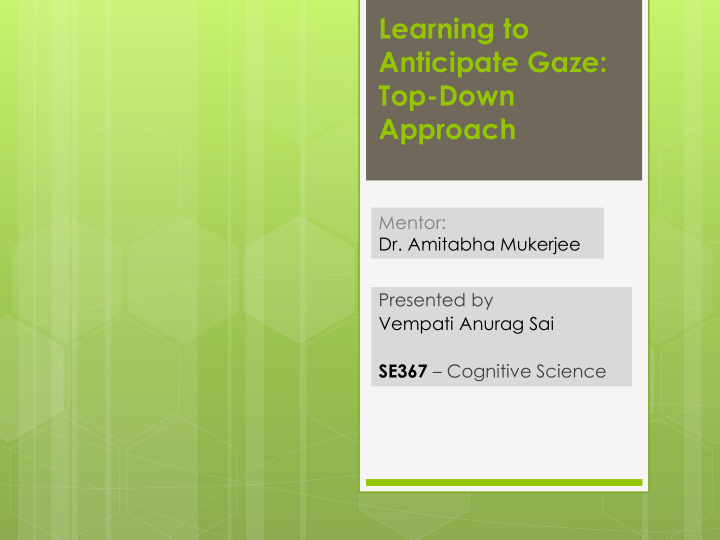



Learning to Anticipate Gaze: Top-Down Approach Mentor: Dr. Amitabha Mukerjee Presented by Vempati Anurag Sai SE367 – Cognitive Science
Introduction Humans deploy anticipatory gaze in many situations. While moving around, driving… Google’s self driving car has a Kalman Filter that tracks each and every vehicle in its sight and anticipates their future positions so that it doesn’t run into them. Human Gaze – Tightly connected to motor resonance system. [Sciuttu et al.] Sports persons. Batsmen’s eye movements monitor the moment when the ball is released, make a predictive saccade to the place where they expect it to hit the ground, wait for it to bounce, and follow its trajectory for 100 – 200 ms after the bounce. [Land & McLeod]
Introduction
Mechanism Basically, hoping to achieve the degree of anticipation as in a professional cricketer The model is learnt in unsupervised fashion. Various sequences of a ball bouncing off the walls/floor viewed from different viewpoints is created for the training phase.
Mechanism Then we search for any moving round objects. The pixel coordinates and size of the ball are stored to get a dataset for training phase. Segmentation/ Optical flow will be a better choice in general. But, since we know the shape of object, better options are available. ‘Canny edge detector’ + ‘Hough Transform’
Mechanism Size of the ball gives ‘z’ component. Using (x, y, z) pairs in the dataset, learn the state transition matrix F . Regression problem. State Transition Matrix State vector
Mechanism Kalman Filter is then used to predict the trajectory in advance. Why Kalman Filter? Takes care of Noisy Measurements Just the measurement of position will do Several cycles of prediction can be done before next measurement update
Kalman Filter Assumes the true state at time k is evolved from the state at (k-1) according to: F k is the state transition model which is applied to the previous state x k-1 B k is the control-input model which is applied to the control vector u k w k is the process noise which is assumed to be drawn from a zero mean multivariate normal distribution with covariance Q k . At time k an observation (or measurement) z k of the true state x k is made according to where H k is the observation model which maps the true state space into the observed space and v k is the observation noise which is assumed to be zero mean Gaussian noise with covariance R k
What next? Evaluate performance on real videos Answer the bigger question! Better Learning Paradigm Compare human gaze anticipation with the developed model
REFERENCES Land, Michael F., and Peter McLeod. "From eye I. movements to actions: how batsmen hit the ball." Nature neuroscience 3.12 (2000): 1340-1345. Sciutti, Alessandra, et al. "Anticipatory gaze in II. human-robot interactions." Gaze in HRI from modeling to communication” workshop at the 7th ACM/IEEE international conference on human-robot interaction, Boston, Massachusetts, USA . 2012. Perse, Matej, et al. "Physics-based modelling of III. human motion using kalman filter and collision avoidance algorithm." International Symposium on Image and Signal Processing and Analysis, ISPA05, Zagreb, Croatia. 2005. http://en.wikipedia.org/wiki/Kalman_filter IV.
QUESTIONS??
Recommend
More recommend